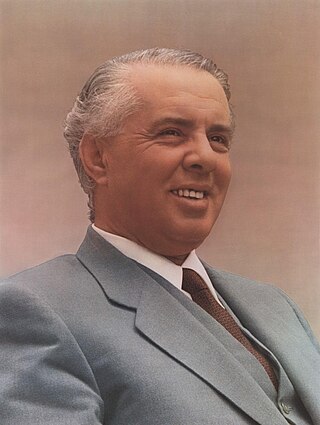
Enver Hoxha was an Albanian communist politician who was the ruler of Albania from 1944 until his death in 1985. He was the First Secretary of the Party of Labour of Albania from 1941 until his death, a member of its Politburo, chairman of the Democratic Front of Albania, and commander-in-chief of the Albanian People's Army. He was the twenty-second prime minister of Albania from 1944 to 1954 and at various times was both foreign minister and defence minister of the country.

Tirana is the capital and largest city of Albania. It is located in the centre of the country, enclosed by mountains and hills, with Dajti rising to the east and a slight valley to the northwest overlooking the Adriatic Sea in the distance. It is among the wettest and sunniest cities in Europe, with 2,544 hours of sun per year.

Nexhmije Hoxha was an Albanian communist politician. For many years she was the wife of Enver Hoxha, the first leader of the Socialist People's Republic of Albania and the First Secretary of the Party of Labour of Albania. Very close to her husband, she attempted to remain politically influential after his death in 1985. She was one of the few spouses of a ruling communist party leader with a high political profile of her own.
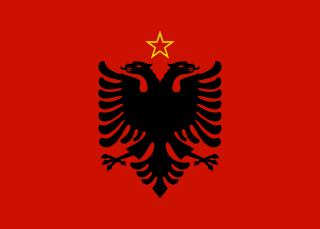
The People's Socialist Republic of Albania, officially the People's Republic of Albania from 1946 until 1976, and from 1991 to 1992 as the Republic of Albania, was the communist state in Albania from 1946 to 1991. It succeeded the Democratic Government of Albania (1944–1946).

The fall of communism in Albania, the last such event in Europe outside the Soviet Union, started in December 1990 with student demonstrations in the capital, Tirana, although protests started in January that year in other cities like Shkodra and Kavaja. The Central Committee of the communist Party of Labour of Albania allowed political pluralism on 11 December and the largest opposition party, the Democratic Party, was founded the next day. March 1991 elections left the Party of Labour in power, but a general strike and urban opposition led to the formation of a "stability government" that included non-communists. Albania's former communists were routed in elections in March 1992 amid economic collapse and social unrest, with the Democratic Party winning most seats and its party head, Sali Berisha, becoming president.

The establishment of diplomatic relations between Albania and the Soviet Union happened on April 7, 1924. Both countries were also allies in the Warsaw Pact. Albania has an embassy in Moscow. Russia has an embassy in Tirana.

Zef Pashko Shoshi is an Albanian painter, painting in socialist realism. Shoshi is considered a national art treasure in Albania.

Relations between Albania and Serbia have been complex and largely unfriendly due to a number of historical and political events.

The National Liberation Movement, also translated as National Liberation Front, was an Albanian communist resistance organization that fought in World War II. It was created on 16 September 1942, in a conference held in Pezë, a village near Tirana, and was led by Enver Hoxha. Apart from the figures which had the majority in the General Council it also included known nationalists like Myslim Peza. In May 1944, the Albanian National Liberation Front was transformed into the government of Albania and its leaders became government members, and in August 1945, it was replaced by the Democratic Front.

The Skanderbeg Square is the main plaza in the centre of Tirana, Albania. The square is named after the Albanian national hero Gjergj Kastrioti Skënderbeu. The total area is about 40,000 square metres. The Skanderbeg Monument dominates the square.

Beqir Balluku was an Albanian politician, military leader, and Minister of Defense of Albania. Balluku assisted Enver Hoxha in carrying out the 1956 purge within the Party of Labour. However, in 1974, Balluku himself, along with a group of other government members was accused by Hoxha of an attempted coup d'état against the Albanian People's Republic. He was executed the next year.

Ish-Blloku, commonly Blloku, is an upmarket area in Tirana, Albania. It widely known as an entertainment destination with its boutiques, shops, restaurants, trendy bars, pubs, and cafes. The area is part of the neighbourhood of Tirana e Re in southwestern Tirana. During the peak summer months, its trendy bars transfer along the Albanian Riviera.
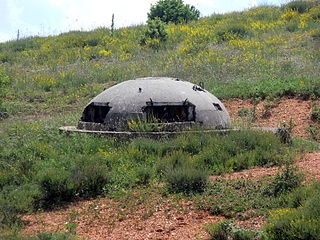
Concrete military bunkers are a ubiquitous sight in Albania, with an average of 5.7 bunkers for every square kilometer. The bunkers were built during the Hoxhaist government led by the Leader Enver Hoxha from the 1960s to the 1980s, as the government fortified Albania by building more than 750,000 bunkers.
Bedri Spahiu was an Albanian politician and Lieutenant-General and one of the most prominent figures of the Albanian Labour Party up to 1956.
Blendi Fevziu is an Albanian journalist, writer and host of the TV talk show Opinion, which first went on air on August 31, 1997.
Ramadan Çitaku (1914-1990) was an Albanian politician of the Party of Labour of Albania. A native of Kosovo, he was one of the founding members of the Albanian Communist Party, member of the General Council of the National Liberation Movement during World War II, Minister of Finance of Albania, and diplomat.

Arena Kombëtare is an all-seater, multi-purpose football stadium located in the capital city of Tirana which was built on the ground of the former Qemal Stafa Stadium. The stadium has a seating capacity of 22,500 constituting the largest stadium in Albania.
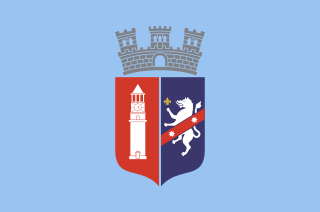
The Culture of Tirana concerns the arts, music, museums, festivals and other entertainment in the capital city of Albania. Tirana is one of the country's leading business and cultural centers including entertainment, music, media, fashion, and the arts all contribute to its status as Albania's largest city.
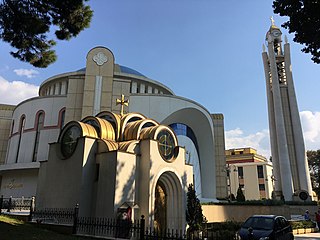
There are many landmarks in Tirana, Albania some of which are of considerable historical or artistic interest. Many monuments and landmarks situated in Tirana, date back to the Illyrian, Roman, Greek and Ottoman periods.

Armando Lulaj is an artist, playwright, filmmaker, and film producer, living and working in Tirana, Albania. His work “constantly negotiates the borders between economical power, fictional democracy and social disparity in a global context.” Lulaj is the founder of DebatikCenter of Contemporary Art. Lulaj has been called “one of the most prominent Albanian artists of his generation.” Since 2022, Lulaj is a member of the art collective Manifesto.





















